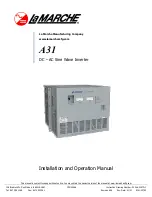
Betriebsanleitung BSC624-12V-B
User’s manual BSC624-12V-B
BSC624-12V-B_User_Manual_110531a.docx
20 / 52
5.2.2.10 IL1, IL2 (Interlock), Pins 19, 20
Der Interlock ist eine sicherheitsrelevante Funktion,
die intern verarbeitet wird, aber auch durch ein
übergeordnetes System (Bsp.: Fahrzeugsystem)
ausgewertet werden kann. Die Interlockverbindung
ist durch die HV-Steckverbindung geschleift (Brücke
im kundenseitigen HV-Stecker) und erlaubt so die
Überprüfung, ob dieser Stecker ordnungsgemäss
angeschlossen ist. Das Gerät verfügt über zwei un-
abhängige Interlocküberwachungsschaltungen:
Interne Interlockerkennung
Externe Interlockerkennung
Die
interne Interlockerkennung
funktioniert unab-
hängig von der Verwendung der externen Erken-
nung und überwacht ausschliesslich, ob der HV-
Stecker richtig angeschlossen ist. Bei einem Fehler
wird das Signal INTL_OC_int* gesetzt und über
CAN der Fehler „CRE_INTERLOCK“ ausgegeben.
Aus Sicherheitsgründen kann die interne Interlo-
ckerkennung nicht deaktiviert werden.
Durch Verwendung der
externen Interlockerken-
nung
kann nicht nur die eigene HV-Steckverbin-
dung, sondern auch jene von zusätzlichen Geräten
überprüft werden.
Hierfür muss durch den Kunden das Inter-
locksignal in Form eines DC-Stroms von min-
destens 20mA bei Pin 19 bzw. 20 eingespeist
werden, wobei die Polarität keine Rolle spielt.
Im PARAM-Tool überprüfen, ob die externe In-
terlockerkennung tatsächlich aktiviert ist und
gegebenenfalls korrigieren.
Falls nun irgendeine der überwachten Steck-
verbindungen nicht richtig kontaktiert ist, ist die
Schleife offen und der eingeprägte Strom kann
nicht mehr fliessen. Bei Unterschreiten einer
Schwelle von ca. 15mA wird das Signal
INTL_OC_ext* gesetzt und über CAN der Feh-
ler „CRE_INTERLOCK“ ausgegeben.
The interlock is a safety relevant function, which is
processed internally but may also be evaluated by a
superior system (e.g.: vehicle system). The interlock
is looped through the HV-connection (wire link in
customer side HV-connector) and allows therefore
to monitor if this connector is connected properly to
the device. The device offers two independently op-
erating interlock monitoring circuits:
Internal interlock detection
External interlock detection
The
internal interlock detection
operates inde-
pendently of the usage of the external interlock de-
tection and monitors exclusively, if the HV-
connector is plugged in properly. In case of a failure
the signal INTL_OC_int* is set and the error
„CRE_INTERLOCK“ is sent by CAN. Due to safety
reasons the internal interlock detection cannot be
deactivated.
The usage of the
external interlock detection
al-
lows to not only monitor the own HV-connection but
also those of additional devices.
For this purpose the customer must inject the in-
terlock signal in form of a DC-current of mini-
mum 20mA at pin 19, resp. 20, whereas the po-
larity does not matter.
Check in the PARAM-tool, whether the external
interlock detection is actually activated and cor-
rect if necessary.
If now any of the monitored connections is not
connected properly to the device, the loop is
open and the injected current may not flow.
When the current falls below a level of app.
15mA, the signal INTL_OC_ext* is set and the
error „CRE_INTERLOCK“ is sent by CAN.
Interne Beschaltung
Internal Circuit
1
0
n
F
IL2 (20)
IL1 (19)
IL2 (2)
IL1 (1)
High voltage
power connector
12mH
12mH
1
0
n
F
4
7
0
p
F
4
7
0
p
F
51uH
51uH
Int. Interlock
Processing
(INTL_OC_int*)
62Ω
100nF
30k
Ω
1
0
u
F
5V
Interlock-Error
(INTL_OC_ext*)
R4
















































